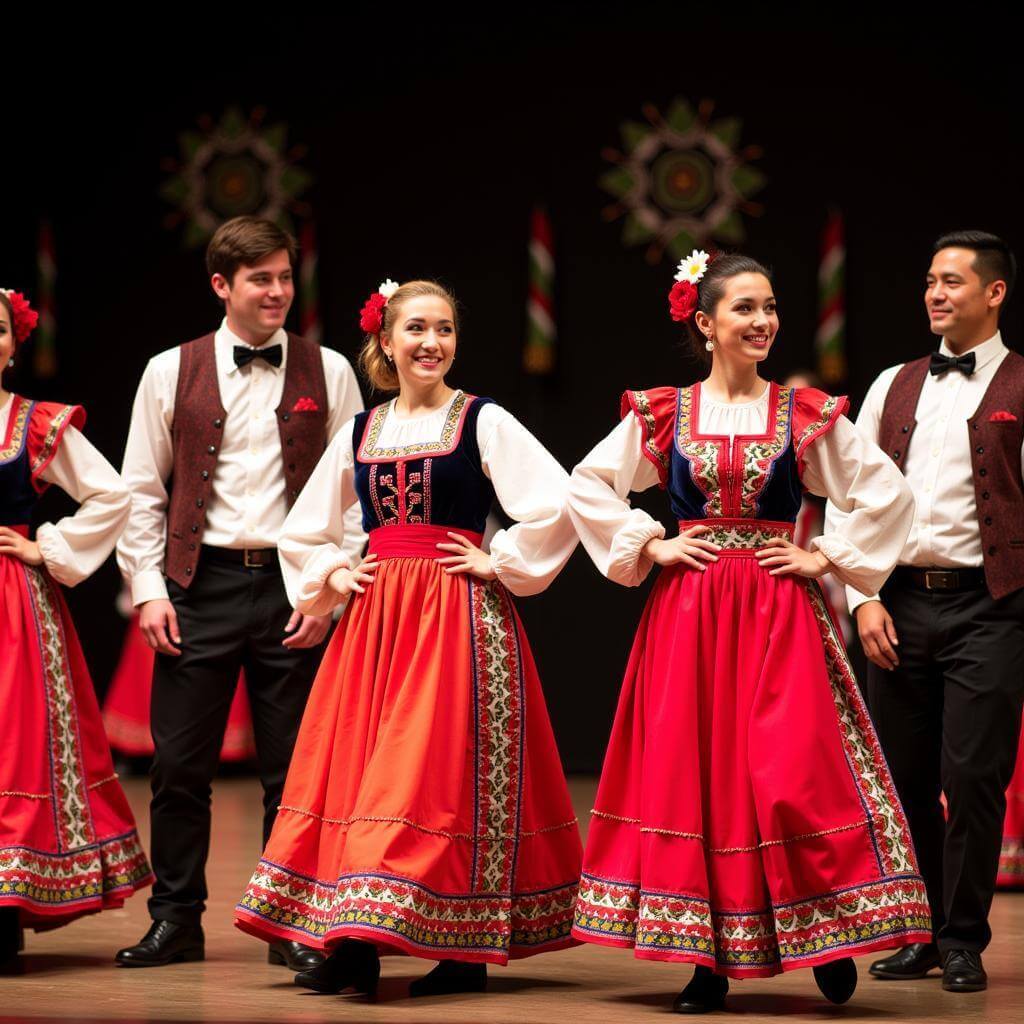In the IELTS Speaking test, candidates often encounter questions about cultural traditions and performances. One popular topic is describing a traditional dance from your country. This article will provide you with valuable insights and strategies to excel in this task, helping you achieve a high band score in your IELTS Speaking exam.
Part 1: Introduction and Interview
In the first part of the Speaking test, the examiner may ask you some general questions about dance and cultural performances. Here are some common questions you might encounter:
- Do you enjoy dancing?
- Have you ever learned any traditional dances?
- How important are traditional dances in your culture?
Let’s look at a sample answer for the third question:
Examiner: How important are traditional dances in your culture?
Sample Answer (Band 7-8):
Traditional dances play a crucial role in our culture. They serve as a living link to our heritage, helping us preserve and celebrate our history. These dances are often performed during festive occasions and cultural events, bringing communities together and fostering a sense of national pride. Moreover, they act as a unique form of artistic expression, showcasing the diversity and richness of our cultural traditions to both locals and tourists alike.
Describe a cultural event or festival you attended to gain more insights into discussing cultural traditions effectively in your IELTS Speaking test.
Part 2: Long Turn
In this section, you’ll be given a cue card with a topic and some bullet points. Here’s a sample cue card related to traditional dance:
Describe a traditional dance or performance from your country
You should say:
- What the dance is called
- When people perform this dance
- What the dance represents or symbolizes
- And explain why you think this dance is important for your culture Traditional dancers performing in colorful costumes
Traditional dancers performing in colorful costumes
Sample Answer (Band 8-9):
I’d like to talk about a traditional dance from my country called the “Naga Dance”, which originates from the northeastern state of Nagaland in India.
The Naga Dance is typically performed during the Hornbill Festival, a vibrant cultural extravaganza held annually in December. This festival showcases the rich heritage of the Naga tribes and attracts tourists from all over the world.
This dance symbolizes the warrior spirit of the Naga people. The dancers, adorned in colorful traditional attire complete with intricate headgear, move in rhythmic steps while brandishing spears and shields. The dance mimics battle formations and hunting techniques, reflecting the historical lifestyle of the Naga tribes.
The importance of this dance in our culture cannot be overstated. Firstly, it serves as a living repository of our ancestral traditions, helping to preserve our unique cultural identity in an increasingly globalized world. Secondly, the dance acts as a powerful medium of storytelling, passing down tales of valor and tribal history from one generation to the next. Lastly, it fosters community bonding and instills a sense of pride in our cultural heritage, especially among the younger generation who might otherwise be disconnected from their roots.
In essence, the Naga Dance is not just a performance, but a vibrant celebration of our history, values, and way of life. It’s a testament to the resilience of our cultural traditions and plays a crucial role in maintaining our cultural continuity.
Examiner’s Follow-up Questions:
- How has this traditional dance evolved over time?
- Do you think young people are interested in learning traditional dances?
Sample Answer for Question 1 (Band 8-9):
The Naga Dance has undergone a fascinating evolution over the years. While the core elements and symbolic gestures remain intact, there have been some notable adaptations. For instance, the dance has become more stylized and choreographed for stage performances, especially during cultural festivals. This has made it more visually appealing to audiences while still preserving its authenticity. Additionally, there’s been a fusion of traditional and modern elements in some performances, incorporating contemporary music or costumes to appeal to younger generations. However, efforts are always made to strike a balance between innovation and tradition, ensuring that the dance’s cultural significance is not diluted.
Describe a skill you have recently learned for more ideas on how to discuss learning and personal development in your IELTS Speaking test.
Part 3: Two-way Discussion
In this part, the examiner will ask you more abstract questions related to the topic. Here’s a sample question and answer:
Examiner: How do you think globalization is affecting traditional cultural practices like dance?
Sample Answer (Band 8-9):
Globalization has had a profound impact on traditional cultural practices, including dance, and this impact is multifaceted. On one hand, globalization has facilitated cultural exchange on an unprecedented scale, allowing traditional dances to reach global audiences through international festivals, social media, and cultural tourism. This exposure has sparked renewed interest in traditional practices and has sometimes led to a revival of forgotten dance forms.
However, there’s also a flip side to this coin. The homogenizing effect of global culture can pose a threat to local traditions. Young people, in particular, might be more drawn to international pop culture and modern dance forms, potentially leading to a decline in interest for traditional dances. There’s also the risk of commercialization, where traditional dances are modified to cater to tourist expectations, potentially diluting their authenticity.
That being said, many communities are finding ways to strike a balance. They’re adapting traditional dances to contemporary contexts while still preserving their core elements and cultural significance. For instance, some choreographers are creating fusion performances that blend traditional movements with modern dance styles, making them more appealing to younger generations while still honoring their cultural roots.
Ultimately, while globalization presents challenges, it also offers opportunities for traditional dances to evolve and reach wider audiences. The key lies in finding ways to embrace change while maintaining cultural integrity.
Describe a festival celebrated in your culture to explore more about discussing cultural traditions and their significance in the IELTS Speaking test.
Key Vocabulary and Phrases for High Scores
Here are some advanced vocabulary and phrases that can help you achieve a higher band score:
-
Cultural heritage (noun) /ˈkʌltʃərəl ˈherɪtɪdʒ/: The legacy of physical artifacts and intangible attributes of a group or society.
Example: “Traditional dances are an integral part of our cultural heritage.” -
Symbolize (verb) /ˈsɪmbəlaɪz/: To represent or stand for something.
Example: “The movements in this dance symbolize the changing seasons.” -
Preserve (verb) /prɪˈzɜːv/: To maintain something in its original or existing state.
Example: “These dances help preserve our ancestral traditions.” -
Authentic (adjective) /ɔːˈθentɪk/: Genuine or original, not fake or imitation.
Example: “We strive to keep our performances as authentic as possible.” -
Evolve (verb) /ɪˈvɒlv/: To develop gradually.
Example: “Traditional dances have evolved over time to remain relevant.”
Describe a job that you think is important in society to learn more about discussing societal roles and their significance, which can be applied to talking about cultural preservationists and dance instructors.
Examiner’s Advice
To achieve a high score in the IELTS Speaking test when discussing traditional dances:
-
Use a range of vocabulary: Incorporate topic-specific terms and advanced vocabulary related to culture, tradition, and performance.
-
Provide detailed descriptions: When describing the dance, be specific about movements, costumes, and the context in which it’s performed.
-
Show critical thinking: Discuss the significance of the dance beyond just its surface-level aspects. Consider its cultural, historical, and social importance.
-
Use appropriate tenses: Use past tense when talking about the dance’s history, present tense for current practices, and future tense when discussing its preservation.
-
Practice fluency: Aim to speak smoothly and confidently, with natural pauses and intonation.
-
Extend your answers: Provide examples, personal experiences, or broader reflections to fully develop your responses.
Remember, the key to success in the IELTS Speaking test is not just about what you say, but how you say it. Practice regularly, record yourself, and listen back to identify areas for improvement. With dedication and the right approach, you can excel in describing traditional dances and other cultural topics in your IELTS Speaking test.
Describe a time when you planned a trip to gain insights into structuring your answers effectively, which can be applied to describing the process of learning or watching a traditional dance performance.


